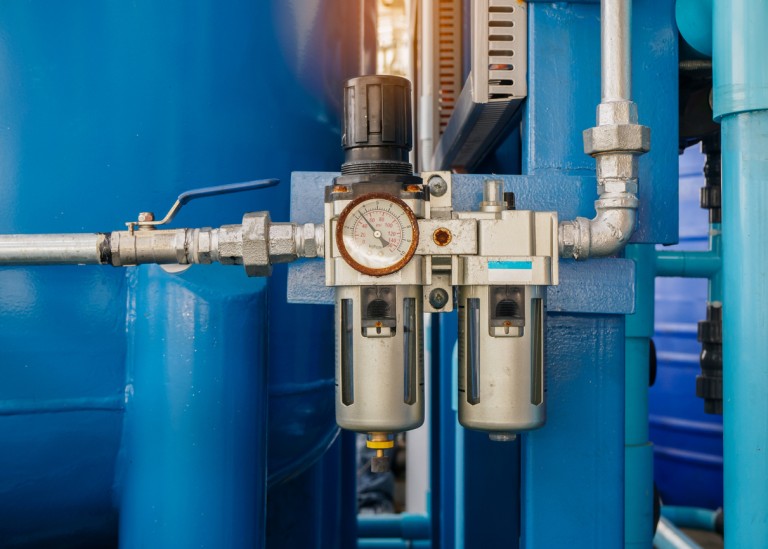
Compressed air systems and compressed gas systems are one of the most critical utilities in a laboratory, food processing plant, cleanroom, or manufacturing environment. It can supply power, support in cleaning, provide necessary gas for analytical equipment, or serve a critical process in a manufacturing process.
The criticality and application types of compressed air/gas systems mean that it is necessary to test these systems for cleanliness & purity; to prevent damage to other equipment, to the compressed air equipment and to products.
There are five (5) key types of measurements for which to test compressed air/gas systems: water, oil, solid particulates, viable bioburden, and for gas systems: purity. In this piece, we will further explore how each type of impurity can occur and will discuss how to test compressed air/gas quality.
Compressed Air Testing Methods
Each of the types of potential air quality issues has different underlying causes and testing methods. In general, compressed air testing is governed by ISO 8573. Depending on the application, additional standards such as USP, or NFPA, may apply.
Testing Compressed Air/Gas Quality for Water
Water vapor (moisture) is a common issue in compressed air/gas systems, as the dewpoint of the air rises as the air becomes more pressurized. Water in compressed air can lead to corrosion of equipment and products, insufficient airflow, and inefficient air delivery. Abundant moisture may also deleteriously effect end products.
Methods of testing for water in compressed air include:
- Hygrometers: These highly precise devices use moisture-sensitive materials to indicate the presence of water in a given airstream. Hygrometers are ideal for testing air from different sources and at different pressures, and are finely calibrated for accuracy and effectiveness.
- Spectroscopic analysis: This method analyzes the visual wavelength spectrum of an air sample, which can indicate the presence of moisture.
- Detection tubes: This method collects an air sample from a compressor and allows for further testing to identify the presence of water vapor.
Testing Compressed Air/Gas Quality for Oil
Oil can frequently be found in compressed air/gas systems due to the lubricating oil required in air compressor equipment, which can easily make its way into the airflow. Oil testing typically occurs for oil vapor as well as condensed and total hydrocarbons (oil aerosol). Oil in compressed air can be an indicator of a leak in equipment — and can also lead to damaged, contaminated, or dirty products. Oil in compressed air/gas systems can also affect air flow rate and capacity.
Methods of testing for oil include:
- Oil aerosol testing: Membranes are used to collect oil from compressed air/gas, which is then dissolved and further analyzed with a spectrometer.
- Oil vapor testing: In this method, a gas chromatography sampling probe tests an airstream for oil vapor particles in the range of 0.001 mg/m3 to 10mg/m. This method is further only suited for compounds with six or more carbon atoms in their chemical makeup.
Testing Compressed Air/Gas Quality for Particles
Solid particles in compressed air/gas systems can occur from debris within equipment as well as in the ambient area, especially where air intake occurs. Particulate can also shed from defects within the air/gas system piping as a by-product of other issues (e.g. rust from line moisture on inappropriate fittings). These contaminants can damage equipment and products, and can have a severe adverse effect on the efficiency of compressor equipment.
The following methods are used to test for particles in compressed air:
- Filter collection: This method uses microscopy and a gridded membrane to visually inspect for solid particulate contamination. It is only suitable for particles larger than 0.1 micron.
- Laser particles counter: This piece of highly specialized, calibrated equipment can assay a sample of compressed air in about 10 minutes, detecting the presence of particles and providing detailed readouts for validation and record keeping.
Testing Compressed Air/Gas Quality for Viable Bioburden
Viable bioburden in a cleanroom or product manufacturing environment poses a risk for the sterility or relative cleanliness of any exposed materials. Viable bioburden may be tested on either compressed air or compressed gas systems. Bioburden is collected and reported for any bacterial, yeast, or mold growth. Relative appropriate levels of bioburden must be set by each facility per the process application.
The following methods are used to test for viable bioburden in compressed air/gas systems:
- Aerobic Viables: aerobic media plates are exposed to compressed air, or appropriately aerobic compressed gas. Exposure of air is achieved through controlled flow through a multi-point impaction sampler.
- Anaerobic Viables: anaerobic media plates are exposed to compressed gas for anaerobic gas systems. Exposure of gas is achieved through controlled flow through a multi-point impaction sampler. Plates are then handled, and incubated, anaerobically.
Testing Compressed Gas Quality for Purity
Compressed gas systems may require additional testing for purity. Percentage purity of the tested gas, and relative levels of impurities, vary by application and gas type.
The following methods are used to test for purity in compressed gas systems:
- Onsite measurement: calibrated equipment is used to directly measure and report purity results for the given gas system. Impurities are most often measured only through lab analysis.
- Lab analysis: analytical tests are run on pure samples collected and delivered to a laboratory; chromatography or spectroscopic methods are utilized to report per the specific purity/impurity requirements
With this understanding of the types of potential impurities for compressed air/gas systems, as well as the reasons that they must be detected and addressed, you are prepared to keep your industrial operations running smoothly and efficiently while eliminating contaminants and damage to equipment and products.
Different testing methods have different degrees of suitability and labor-intensity. Technical Safety Services can help you determine the right tools for your needs. With a full suite of laboratory testing and validation services across all industries, we are ready to discuss your application today. Contact us to learn more.

